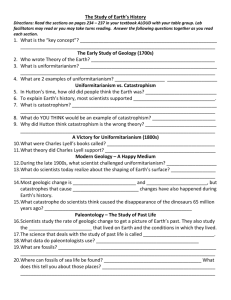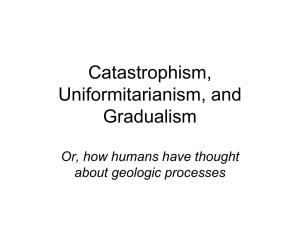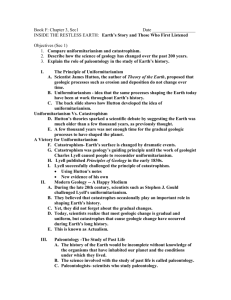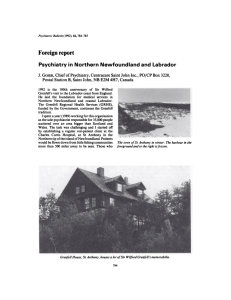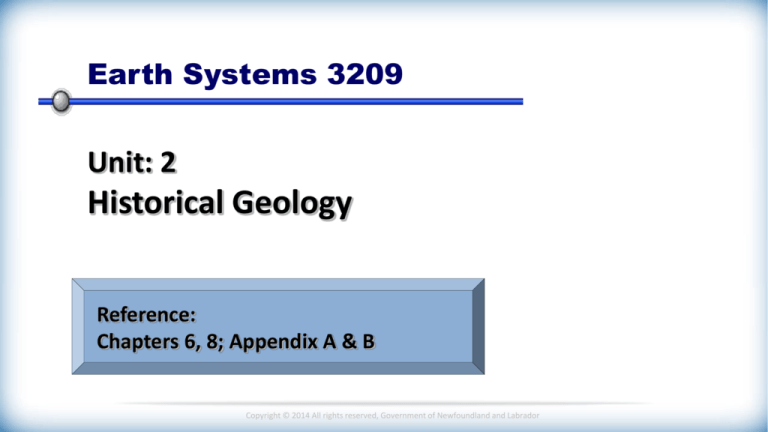
Earth Systems 3209
Unit: 2
Historical Geology
Reference:
Chapters 6, 8; Appendix A & B
Copyright © 2014 All rights reserved, Government of Newfoundland and Labrador
Unit 2:
Topic 1.1
Uniformitarianism “vs” Catastrophism
Focus on . . .
recognizing that Uniformitarianism is a fundamental
principle of geology and contrast this principle with
catastrophism.
Copyright © 2014 All rights reserved, Government of Newfoundland and Labrador
Historical Geology
Science is the investigation of ideas. Throughout
history, scientific ideas (paradigms) change as
new evidence is discovered regarding scientific
models and theories.
These changing ideas were demonstrated
throughout geologic history. One notable
change that formed the framework for geologist
is the movement from Catastrophic ideas to one
of uniformity, hence the birth of the principle of
Uniformitarianism.
Copyright © 2014 All rights reserved, Government of Newfoundland and Labrador
Text
Reference:
pages 5-6
Doctrine of Catastrophism:
Catastrophists thought that Earth’s physical features (mountains,
canyons, and almost all landforms) formed by sudden spectacular
events (catastrophes) produced by unknowable causes that no
longer operate and can not be explained by nature. (James Usher)
These ideas attempted to fit the rate of change of Earth’s
processes into a relatively young aged Earth. These scientist
thought Earth was millions and not billions of years old.
This is not to say that catastrophic events do not occur
today, tsunamis, earthquakes, volcanic eruptions, etc.
Copyright © 2014 All rights reserved, Government of Newfoundland and Labrador
Principle of Uniformitarianism:
One idea that helped scientist better understand
the processes acting on Earth is the idea of
Uniformitarianism. This idea was first recognized
by a Scottish Geologist named James Hutton.
After years of studying land forms and rocks,
Hutton came to the conclusion that, “ the present
is the key to the past” and “that, the physical,
chemical, and biological laws that operate today
to shape Earth also operated in the past.”
Copyright © 2014 All rights reserved, Government of Newfoundland and Labrador
Example 1:
Question:
How would the ideas of Catastrophism and Uniformitarianism
explain the formation of the Grand Canyon?
Copyright © 2014 All rights reserved, Government of Newfoundland and Labrador
Example 1:
Question:
How would the ideas of Catastrophism and Uniformitarianism
explain the formation of the Grand Canyon?
Catastrophist:
Sudden event
Unknowable causes
Unexplained
Short period of time
Copyright © 2014 All rights reserved, Government of Newfoundland and Labrador
Example 1:
Question:
How would the ideas of Catastrophism and Uniformitarianism
explain the formation of the Grand Canyon?
Uniformitarianist:
Gradual change
Uniform processes
Long period of time
Copyright © 2014 All rights reserved, Government of Newfoundland and Labrador
Example 2:
Questions:
Which suggests that major Earth features are the result of
sudden disasters of unknowable causes in Earth’s past?
(A) catastrophism
(B) creationism
(C) fundamentalism
(D) uniformitarianism
Which states that the basic laws of nature have remained
unchanged since Earth was created?
(A) catastrophism
(B) correlation
(C) superposition
(D) uniformitarianism
Copyright © 2014 All rights reserved, Government of Newfoundland and Labrador
Example 3:
Question:
Based on the information below, answer the question that follows;
“The Earth has been covered by giant combinations of continents,
called supercontinents, many times in its past, and it will be again
one day in the distant future. The next predicted supercontinent . . .
may form when the Americas and Asia both drift northward to
merge, closing off the Arctic Ocean . . . .”
Charles Q. Choi, Our Amazing Planet
Identify and explain a concept that scientists could use to support the
idea suggested in the above quotation.
Copyright © 2014 All rights reserved, Government of Newfoundland and Labrador
Example 3:
Question:
Identify and explain a concept that scientists could use to support the
idea suggested in the above quotation.
The idea can be supported by the concept of uniformitarianism.
Uniformitarianism explains that the same geologic processes that were
occurring on Earth in the past are still occurring today and will continue
to occur in the future.
Earth has experienced tectonic forces which were responsible for the
formation and destruction of supercontinents in the geologic past. Since
these same forces are still occurring today and will continue to occur in
the future, then it can be concluded that there will once again be
another supercontinent in the future.
Copyright © 2014 All rights reserved, Government of Newfoundland and Labrador
Your Turn . . .
Take the time and complete the following questions . . .
(Solutions to follow)
Question:
With the aid of a specific example, explain how
uniformitarianism can be used to understand
past catastrophic events.
Copyright © 2014 All rights reserved, Government of Newfoundland and Labrador
Solutions . . .
Questions:
With the aid of a specific example, explain how uniformitarianism
can be used to understand past catastrophic events.
The principle of uniformatarianism states that processes that
acted on Earth in the past, are still acting on Earth today and will
continue in the future.
Catastrophic events which occur on Earth today, for example,
earthquakes, are caused by the same processes that caused
earthquakes in the past.
These forces associated with plate tectonics cause present day
earthquakes and are thought to be responsible for causing
earthquakes in the past.
Copyright © 2014 All rights reserved, Government of Newfoundland and Labrador
Another Question and Solution:
Q. Two hikers sit together on a hilltop overlooking a steep-sided
river valley. One hiker explains its formation using
uniformitarianism while the other uses catastrophism.
Summarize each hiker’s explanation of how the valley formed.
A. The hiker that follows an uniformitarianism view would suggest that
the valley formed over an extremely long period of time (perhaps
millions of years) and was formed by physical forces, such as
erosion and weathering, that have affected and shaped Earth for
millions of years. In comparison, a hiker that follows a catastrophic
view would suggest that the valley formed over a relatively shorter
period of time and was formed by some unexplainable, sudden
event commonly called a catastrophe, for example an earthquake,
etc....
Copyright © 2014 All rights reserved, Government of Newfoundland and Labrador
Summary . . .
Overview of Points covered:
Catastrophist:
Uniformitarianist:
Sudden event
Gradual change
Unknowable causes
Uniform processes
Unexplained
Short period of time
Long period of time
Copyright © 2014 All rights reserved, Government of Newfoundland and Labrador


